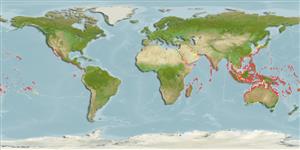>
Eupercaria/misc (Various families in series Eupercaria) >
Labridae (Wrasses) > Xyrichtyinae
Etymology: Iniistius: Latin, in = in + Greek, istion = sail.
More on author: Linnaeus.
Environment: milieu / climate zone / depth range / distribution range
Ecologie
marien rifbewoner; diepte 2 - 30 m (Ref. 90102). Tropical
Indo-Pacific: Red Sea and East Africa to the Pacific.
Grootte / Gewicht / Leeftijd
Maturity: Lm ? range ? - ? cm
Max length : 25.0 cm TL mannelijk / geslacht onbekend; (Ref. 2334)
Dorsale stekels (totaal): 9; Dorsale zachte stralen (totaal): 12; Anale stekels 3; Anale zachte stralen: 12 - 13
Found over sandy bottoms of coastal areas and also in areas with some seagrass or algae. Ranges to a depth of over 18 m (Ref. 9710). Usually in large spread-out groups on upper slopes of sand and mud banks with males defending its section that has numerous females (Ref. 48636). Dives into sand to sleep safely at night or to hide when alarmed (Ref. 90102). When threatened, it dives head-first into sand; may take some time to emerge again. Feeds mainly on hard-shelled prey, including mollusks and crustaceans (Ref. 5374). Minimum depth taken from Ref. 9710.
Levenscyclus en paargedrag
Maturiteit | Voortplanting | Paaien | Eieren | Fecunditeit | Larven
Pelagic spawner.
Randall, J.E., G.R. Allen and R.C. Steene, 1990. Fishes of the Great Barrier Reef and Coral Sea. University of Hawaii Press, Honolulu, Hawaii. 506 p. (Ref. 2334)
Status op de Rode Lijst van het IUCN (Ref. 130435)
Gevaar voor de mens
Harmless
Gebruik door de mens
Visserij: van minder commercieel belang; Aquarium: Commercieel
Meer informatie
ReferentiesAquacultuurAquacultuurprofielKweeklijnenGeneticaElectrophoresesErfelijkheidZiektesVerwerkingNutrientsMassaconversie
Tools
Speciale rapporten
Download XML
Internetbronnen
Estimates based on models
Preferred temperature (Ref.
123201): 24.4 - 29.3, mean 28.3 °C (based on 3300 cells).
Fylogenetische diversiteitsindex (Ref.
82804): PD
50 = 0.5000 [Uniqueness, from 0.5 = low to 2.0 = high].
Bayesian length-weight: a=0.01023 (0.00397 - 0.02640), b=3.06 (2.84 - 3.28), in cm total length, based on LWR estimates for this (Sub)family-body shape (Ref.
93245).
Trofisch niveau (Ref.
69278): 3.6 ±0.50 se; based on food items.
Weerstandsvermogen (Ref.
120179): Gemiddeld, minimale populatieverdubbelingstijd 1,4-4,4 jaar (Preliminary K or Fecundity.).
Fishing Vulnerability (Ref.
59153): Low vulnerability (15 of 100).
Nutrients (Ref.
124155): Calcium = 60.7 [37.1, 98.7] mg/100g; Iron = 0.619 [0.367, 1.115] mg/100g; Protein = 18.6 [15.7, 20.8] %; Omega3 = 0.146 [0.097, 0.220] g/100g; Selenium = 25.1 [15.8, 43.5] μg/100g; VitaminA = 124 [39, 440] μg/100g; Zinc = 1.45 [1.02, 2.23] mg/100g (wet weight);
